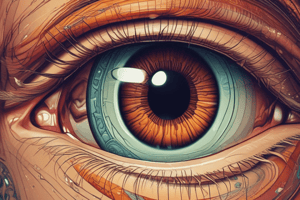Podcast
Questions and Answers
What is the direction of the passage of the infraorbital canals and foramen?
What is the direction of the passage of the infraorbital canals and foramen?
- From the face region to the orbit region
- From the nasal region to the orbit region
- From the orbit region to the nasal region
- From the orbit region to the face region (correct)
What is the location of the infraorbital canals and foramen?
What is the location of the infraorbital canals and foramen?
- In the face region
- In the orbit region (correct)
- In the nasal region
- In the forehead region
What is the purpose of the infraorbital canals and foramen?
What is the purpose of the infraorbital canals and foramen?
- To connect the orbit region to the face region (correct)
- To connect the forehead region to the nasal region
- To connect the face region to the forehead region
- To connect the nasal region to the face region
Which region do the infraorbital canals and foramen pass to?
Which region do the infraorbital canals and foramen pass to?
What passes from the orbit region to the face region?
What passes from the orbit region to the face region?
Where is the incisive foramen located?
Where is the incisive foramen located?
What is the function of the alveolar process?
What is the function of the alveolar process?
Which part of the maxilla contains the incisive foramen?
Which part of the maxilla contains the incisive foramen?
What is the alveolar process a part of?
What is the alveolar process a part of?
What does the alveolar process support?
What does the alveolar process support?
Where is the mandibular foramen located?
Where is the mandibular foramen located?
What is the name of the process located anteriorly in the superior part of the ramus?
What is the name of the process located anteriorly in the superior part of the ramus?
What is the name of the notch that separates the coronoid process and the condylar process?
What is the name of the notch that separates the coronoid process and the condylar process?
What is the posterior part of the superior ramus divided into?
What is the posterior part of the superior ramus divided into?
What is the name of the part of the mandible that the mandibular foramen is located on?
What is the name of the part of the mandible that the mandibular foramen is located on?
What is the primary function of the mandible?
What is the primary function of the mandible?
Where is the mental foramen located in relation to the mandible?
Where is the mental foramen located in relation to the mandible?
Which of the following bones does the mandible not form?
Which of the following bones does the mandible not form?
What is a characteristic of the neck?
What is a characteristic of the neck?
What is the name of the foramen located on the anterior part of the lateral surface of the mandible?
What is the name of the foramen located on the anterior part of the lateral surface of the mandible?
On which surface of the mandible is the mental foramen located?
On which surface of the mandible is the mental foramen located?
Where does the lateral pterygoid muscle attach?
Where does the lateral pterygoid muscle attach?
What is the location of the pterygoid fovea?
What is the location of the pterygoid fovea?
What structure forms a condyle?
What structure forms a condyle?
Which muscle is attached to the neck?
Which muscle is attached to the neck?
Study Notes
Maxilla
- Has a neck that forms a condyle superiorly
- Lateral pterygoid muscle attaches to pterygoid fovea on the neck
- Infraorbital canals and foramen pass from the orbit region to the face region
- Incisive foramen located in the anterior portion
- Alveolar process supports all maxillary teeth
Mandible
- Forms the lower jaw
- Superior part divides into coronoid process anteriorly and condylar process posteriorly
- Mandibular notch separates coronoid and condylar processes
- Mandibular foramen located on medial side of ramus
- Mental foramen lies on anterior part of lateral surface of the body
Studying That Suits You
Use AI to generate personalized quizzes and flashcards to suit your learning preferences.
Description
Test your knowledge of the infraorbital canals and foramen that connect the orbit region to the face region. Learn about the anatomy of the eye and surrounding structures. Identify the passages that allow nerves and vessels to pass through.




